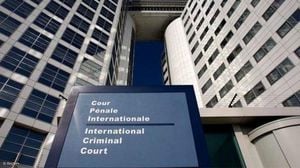Millions of internet users across the Middle East and South Asia have been grappling with sluggish speeds and intermittent outages since a series of undersea cable breaks struck the Red Sea route beginning on Saturday, September 6, 2025. The disruption, which has rippled across countries from India and Pakistan to Kuwait and the United Arab Emirates, highlights the fragility of the digital infrastructure that underpins global communications and commerce.
According to NetBlocks, an organization that monitors global internet access, “a series of subsea cable outages in the Red Sea has degraded internet connectivity in multiple countries,” including India and Pakistan. The affected systems are the South East Asia-Middle East-Western Europe 4 (SMW4) and the India-Middle East-Western Europe (IMEWE) cables, both of which have landing points near Jeddah, Saudi Arabia. The SMW4 cable, operated by Tata Communications, stretches 18,800 kilometers from Marseille and Palermo to Singapore, connecting numerous Asian and North African countries along the way. The IMEWE cable, managed by a consortium led by Alcatel Submarine Networks, links France and Italy to India over a 12,091-kilometer route through the Middle East.
Cloudflare Radar, another internet monitoring service, confirmed the widespread outages on Saturday. Notably, latency between Delhi and London jumped by 20% starting at 23:00 UTC, while latency between Mumbai and Frankfurt surged by 30%. These delays persisted through Sunday, with average latency remaining higher than usual. In Kuwait, government officials attributed local internet disruptions to a cut in the FALCON GCX cable, another major subsea line running through the Red Sea. The FALCON cable’s operator, GCX, did not respond to requests for comment.
The United Arab Emirates was also hit hard. Customers on the state-owned Du and Etisalat networks complained of slow speeds and patchy service, a situation confirmed by NetBlocks and echoed by Cloudflare. “Slow speeds and intermittent access as engineers work to resolve the issue impacting multiple countries,” NetBlocks reported, specifically naming Du and Etisalat as affected providers. Despite the mounting complaints, UAE authorities did not publicly acknowledge the disruption.
Microsoft, whose Azure cloud platform is widely used by businesses and governments in the region, acknowledged the problem on its status website. “Network traffic traversing through the Middle East may experience increased latency due to undersea fibre cuts in the Red Sea,” the company stated. While Microsoft was able to reroute traffic through alternate pathways to minimize the impact, it warned that “higher latency on some traffic that previously traversed through the Middle East” was to be expected. The company added, “Undersea fibre cuts can take time to repair, as such we will continuously monitor, rebalance, and optimize routing to reduce customer impact in the meantime.” By Saturday evening, Microsoft reported that Azure-related issues had largely subsided, though some users continued to experience delays as of Sunday.
Pakistan’s telecommunications authority also issued a warning to customers, confirming the cable cuts and advising that slowdowns would be most noticeable during peak hours. In India, the impact was felt by millions, as the SMW4 cable is a critical artery for international data traffic. The widespread nature of the outages underscores how dependent the region has become on a handful of key undersea cables.
While the immediate cause of the cable failures remains undetermined, speculation has swirled about the possibility of deliberate sabotage. Sky News and other outlets have noted that Yemen’s Houthi rebels, who have been engaged in a campaign to pressure Israel over the Gaza conflict, have been accused in the past of plotting attacks on Red Sea cables. The Houthis, for their part, have denied any involvement. Earlier in 2024, several cables in the Red Sea were cut following warnings from Yemen’s internationally recognized government about potential sabotage; again, the Houthis denied responsibility.
The Red Sea is no stranger to such incidents. In February 2024, anchor drag was blamed for severing the Seacom, EIG, and AAE-1 cable systems in the same waters, causing widespread disruption between Asia and Europe. The region is a chokepoint for global data flows, and when multiple cables are damaged at once, the ability to reroute traffic is severely constrained, leading to the kind of network slowdowns witnessed this week.
Globally, there are approximately 1.7 million kilometers of undersea cables, according to the International Cable Protection Committee. These vital lines experience between 150 and 200 incidents a year, with up to 80% resulting from accidental human activity—think fishing nets or ship anchors—while the rest are due to natural hazards or, in rare cases, deliberate attacks. Repairing a damaged cable is no small feat: specialized ships must locate the break, haul the cable to the surface, splice or replace the damaged section, and then carefully lower it back to the seabed—a process that can take weeks.
The growing frequency of such incidents, both accidental and suspicious, has prompted international action. In December 2024, the International Telecommunication Union (ITU), the United Nations Agency for Digital Technologies, and the International Cable Protection Committee formed the International Advisory Body for Submarine Cable Resilience. This new body aims to bolster cable protection through global cooperation, risk mitigation, and the promotion of diverse routes and landings to enhance resilience. In February 2025, the group issued a declaration promoting these goals and established working groups to focus on risk identification, monitoring, and rapid response.
The persistent vulnerability of undersea cables is not lost on industry leaders. Steve Roberts, Senior Vice President of Network Investment at Exa Infrastructure, remarked, “There have been many stories of high-profile cable cuts this year, highlighting the need for greater network redundancy. We are so reliant on these vital pathways to transport data, that more investment into alternative paths is needed to ensure that when a cable is down, whatever the reason, traffic isn’t impacted.” Roberts added, “We are seeing governments and regulators starting to take the security of subsea cables more seriously, and this, coupled with continued investment into new projects, will mean that the impact of outages can be lessened in future.”
Yemen’s Minister of Information and Culture, Moammar al-Eryani, called the latest incident a “wake-up call for the international community.” He emphasized that subsea cable networks are not just essential for global trade but are increasingly vulnerable amid escalating geopolitical tensions.
For ordinary users across the affected regions, the consequences are tangible: slower internet speeds, longer loading times, and occasional service dropouts. Cloud services, video calls, and online business operations have all been affected, serving as a stark reminder of just how much modern society depends on these unseen arteries beneath the sea. As repair crews mobilize and governments debate how to better protect these critical links, the world watches closely—hoping that the next outage is not just around the corner.





